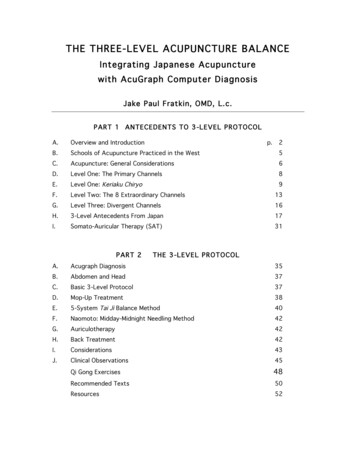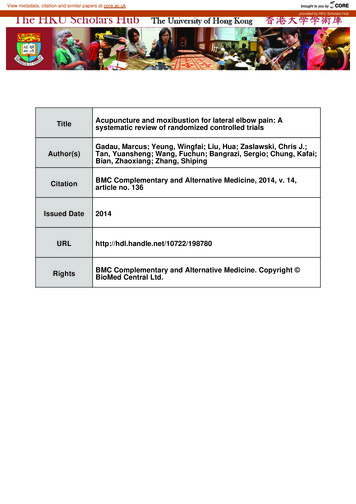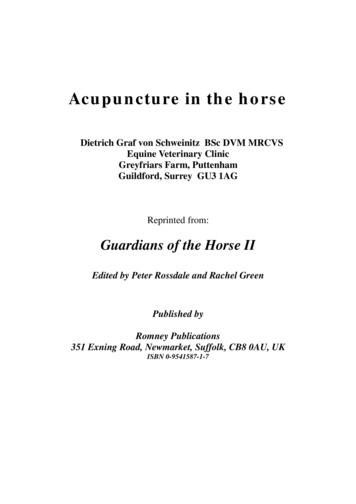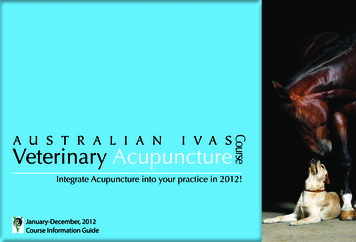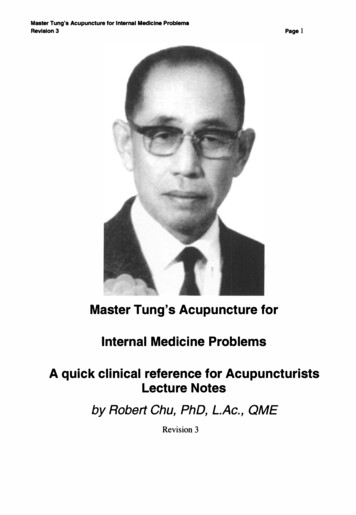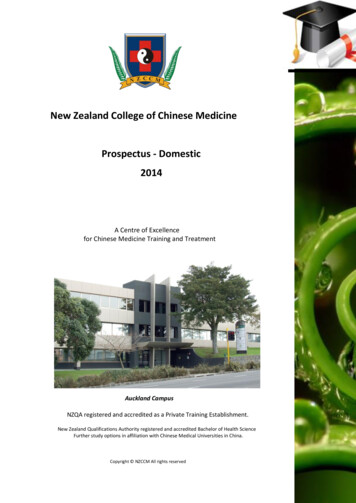
Transcription
Department of Veterans AffairsHealth Services Research & Development ServiceEvidence-based Synthesis ProgramEvidence Map of AcupunctureJanuary 2014Prepared for:Department of Veterans AffairsVeterans Health AdministrationQuality Enhancement Research InitiativeHealth Services Research & Development ServiceWashington, DC 20420Prepared by:Evidence-based Synthesis Program (ESP) CenterWest Los Angeles VA Medical CenterLos Angeles, CAPaul G. Shekelle, MD, PhD, DirectorInvestigators:Principal Investigators:Susanne Hempel, PhDPaul G. Shekelle, MD, PhDCo-Investigators:Stephanie L. Taylor, PhDMichelle R. Solloway, PhDResearch Associates:Isomi M. Miake-Lye, BAJessica M. Beroes, BSRoberta Shanman, MSMarika J. Booth, MSAndrew M. Siroka, BS
Evidence Map of AcupunctureEvidence-based Synthesis ProgramPREFACEQuality Enhancement Research Initiative’s (QUERI) Evidence-based Synthesis Program(ESP) was established to provide timely and accurate syntheses of targeted healthcare topicsof particular importance to Veterans Affairs (VA) managers and policymakers, as they work toimprove the health and healthcare of Veterans. The ESP disseminates these reports throughoutVA.QUERI provides funding for four ESP Centers and each Center has an active VA affiliation. TheESP Centers generate evidence syntheses on important clinical practice topics, and these reportshelp: develop clinical policies informed by evidence,guide the implementation of effective services to improve patientoutcomes and to support VA clinical practice guidelines and performancemeasures, andset the direction for future research to address gaps in clinical knowledge.In 2009, the ESP Coordinating Center was created to expand the capacity of QUERI CentralOffice and the four ESP sites by developing and maintaining program processes. In addition,the Center established a Steering Committee comprised of QUERI field-based investigators,VA Patient Care Services, Office of Quality and Performance, and Veterans Integrated ServiceNetworks (VISN) Clinical Management Officers. The Steering Committee provides programoversight, guides strategic planning, coordinates dissemination activities, and developscollaborations with VA leadership to identify new ESP topics of importance to Veterans and theVA healthcare system.Comments on this evidence report are welcome and can be sent to Nicole Floyd, ESPCoordinating Center Program Manager, at nicole.floyd@va.gov.Recommended citation: Hempel, S., Taylor, S. L., Solloway, M., Miake-Lye, I. M., Beroes, J.M., Shanman, R., Booth, M. J., Siroka, A. M., Shekelle, P. G. Evidence Map of Acupuncture. VAESP Project #05-226; 2013This report is based on research conducted by the Evidence-based Synthesis Program(ESP) Center located at the West Los Angeles VA Medical Center, Los Angeles, CAfunded by the Department of Veterans Affairs, Veterans Health Administration, Officeof Research and Development, Quality Enhancement Research Initiative. The findingsand conclusions in this document are those of the author(s) who are responsible for itscontents; the findings and conclusions do not necessarily represent the views of theDepartment of Veterans Affairs or the United States government. Therefore, no statementin this article should be construed as an official position of the Department of VeteransAffairs. No investigators have any affiliations or financial involvement (e.g., employment,consultancies, honoraria, stock ownership or options, expert testimony, grants or patentsreceived or pending, or royalties) that conflict with material presented in the report.i
Evidence Map of AcupunctureEvidence-based Synthesis ProgramTABLE OF CONTENTSBACKGROUND . 1Key Questions/Scope of Project . 1METHODSInclusion Criteria . 2Search . 2Procedure . 3Data Synthesis . 3Bubble Plots. 4Literature Size . 4Clinical Effectiveness. 4Confidence. 6Other Results . 6Future Research . 6Technical Expert Panel . 7Peer Review . 7RESULTS . 8EVIDENCE MAP OF ACUPUNCTURE FOR PAIN . 10Executive Summary: Pain . 11EVIDENCE MAP OF ACUPUNCTURE FOR WELLNESS . 15Executive Summary: Wellness . 16EVIDENCE MAP OF ACUPUNCTURE FOR MENTAL HEALTH . 19Executive Summary: Mental Health . 20OTHER INDICATIONS . 22ADVERSE EVENTS OF ACUPUNCTURE. 23Reviews of Adverse Events of Acupuncture . 23Pain Domain . 23Wellness Domain. 24Mental Health Domain . 24Other Indications . 24FUTURE RESEARCH . 25Pain Domain . 26Wellness Domain . 26Mental Health Domain . 27Other Indications . 27ii
Evidence Map of AcupunctureEvidence-based Synthesis ProgramONGOING RESEARCH . 28SUMMARY AND LIMITATIONS . 29REFERENCES . 30FIGURESFigure 1: Systematic reviews on acupuncture published January 2005 to March 2013. 8Figure 2: Research volume by priority topic areas . 8BUBBLE PLOTSAcupuncture for Pain . 10Acupuncture for Wellness. 15Acupuncture for Mental Health . 19APPENDIX. PEER REVIEW COMMENTS/AUTHOR RESPONSES . 48iii
Evidence Map of AcupunctureEvidence-based Synthesis ProgramEVIDENCE MAP OF ACUPUNCTUREBACKGROUNDMany Veterans desire complementary and alternative medicine or integrative medicinemodalities such as acupuncture, both for treatment and for the promotion of wellness. However,the effectiveness and adverse events associated with acupuncture are not firmly established.Given the VA’s desire to promote evidence-based practice, this evidence mapping project willhelp provide guidance to VA leadership about the distribution of evidence to inform policy andclinical decision making.In general, acupuncture is the stimulation of specific acupuncture points through penetration ofthe skin with needles, which aims to correct imbalances in the flow of qi, a concept of energyin traditional Chinese medicine (TCM), through meridians (ie, energy channels). The availablepublished literature on acupuncture is extensive. PubMed searches in 2013 identified almost20,000 citations with the term “acupuncture” and almost 1,500 randomized controlled trials(RCTs) with “acupuncture” in the title. Not surprisingly, a large number of systematic reviewsand meta-analyses have been published to-date, and even a number of “reviews of reviews”are available in the published literature on acupuncture in general1-6 or for a specific clinicalcondition.4,7-20Results from existing reviews of reviews about the effectiveness of acupuncture are nonconclusive. A systematic review of systematic reviews of acupuncture published between1996 and 2005 included 35 reviews.1 The overview noted that 12 reviews reported support foracupuncture and 6 reported strong support; however, when applying strict inclusion criteria,such as randomized and double blind studies, good evidence of no benefit was shown. In 2007,Adams compiled a “Brief Overview – A summary of the evidence for use of acupuncture fromsystematic reviews and meta-analyses” for the Veterans Health Administration Office of PatientCare Services Technology Assessment Program.21 The report included 42 systematic reviewspublished since 2002 and concluded that higher quality studies are only beginning to emerge,the evidence base is heterogeneous, and the review results highlight the overall poor quality ofstudies and reporting. Thus, it is timely to assess the current state of reviews of acupuncture.KEY QUESTIONS/SCOPE OF PROJECTThe project deliverables are: An evidence map that provides a visual overview of the distribution of evidence (bothwhat is known and where there is little or no evidence base) for acupuncture; and A set of executive summaries that would help stakeholders interpret the state of theevidence to inform policy and clinical decision making.This project maps the literature for the indications Pain, Mental Health and Wellness; as well asany clinical area for which at least 3 reviews and/or recent large RCTs exist.1
Evidence Map of AcupunctureEvidence-based Synthesis ProgramMETHODSThis systematic review of systematic reviews provides an overview of the existing literature onacupuncture.INCLUSION CRITERIATo be included in the review of reviews, studies had to meet the following criteria: Participants: Reviews and new RCTs including human adult participants undergoingacupuncture for any health-related indication were eligible for inclusion in the evidencemap. Reviews and new RCTs in adult participants or not further specified age groupswere included; reviews and new RCTs exclusively focusing on animals and exclusivelyfocusing on children were excluded. Intervention: Reviews and new RCTs of effects of acupuncture using needles, includingtraditional Chinese acupuncture and other related acupuncture concepts, with or withoutelectro stimulation, with or without moxibustion, and whole body as well as microsystemacupuncture, were eligible. Reviews or RCTs exclusively targeting acupressure, laseracupuncture, transcutaneous electrical nerve simulation, or dry needling were excluded.Reviews on the effectiveness of acupuncture, alone or in combination with othertraditional Chinese medicine approaches, were included. Reviews of clinical indicationsthat included studies of acupuncture among many other interventions, and broad reviewson complementary and alternative medicine approaches without particular focus onacupuncture were not sought. Studies addressing the mechanism of action and correlatesof acupuncture (eg, brain activity), or investigating the comparative effectiveness ofdifferent acupuncture regimes were excluded. Comparator (design): Systematic reviews focusing on acupuncture and summarizingprimary research studies were eligible. Reviews either identified as “systematic review”in the title or abstract of the publication or reporting the search sources in the abstractwere included. In addition, recent, large (N 500 participants) RCTs focusing onacupuncture, reporting patient outcomes, and not yet included in existing reviews wereincluded. RCTs had to report on the sample size or be described as a multicenter study inthe title or abstract to be considered. Outcome: Patient outcomes addressed in reviews or trials were eligible. Reviews andRCTs of provider outcomes, acceptance, prevalence, use, costs, study design features, orintervention features not reporting patient health outcomes in the abstract were excluded. Timing: Reviews and new RCTs including any intervention duration and any followup point were eligible for inclusion. Reviews had to be published in or after 2005 to beincluded, regardless of the publication date of the included studies in the review. Of therecent RCTs, only those not yet included in existing systematic reviews were considered. Setting: Reviews and recent RCTs in healthcare-related settings were eligible. English-language reviews, regardless of the language of the included studies, and recent,large RCTs were eligible for inclusion in the review of reviews.SEARCHFor this project, we searched the electronic databases PubMed using the systematic reviewclinical query; the Database of Abstracts of Reviews of Effects (DARE), a database dedicated2
Evidence Map of AcupunctureEvidence-based Synthesis Programto catalogue systematic reviews in healthcare; the Cochrane Library of Systematic Reviewswhich keeps a record of all ongoing and completed Cochrane reviews; and AMED, the Alliedand Complementary Medicine database, in March 2013 to identify English-language systematicreviews published since 2005 focusing on acupuncture. In addition, we identified relevantreviews through the review registry PROSPERO, published reviews of reviews, and topicexperts.Recently published, large acupuncture RCTs indexed in PubMed and not yet included in existingsystematic review were identified in topic specific searches using the Randomized ControlledTrial filter in PubMed.PROCEDUREIn the first step, we identified systematic reviews meeting the inclusion criteria and removeddata duplicates from the database so that the data from each review entered the dataset onlyonce. This entailed identifying and consolidating online-only and final publication of articles,Cochrane reviews published in the Cochrane database and in a journal article, multiple updatesof Cochrane reviews, and references to systematic reviews differently indexed in general andspecialist systematic review databases. Where originals and updates of systematic reviews by thesame author group were available only the most recent version was considered. These systematicreviews were then coded by clinical topic.Reviews and recent RCTs identified as potentially relevant and all unclear citations were orderedas full text to evaluate the publication against the specified inclusion criteria. The literature flowwas documented in an electronic database. Reasons for exclusion of full text publications wererecorded. Results of individual reviews and recent RCTs were extracted in an online database forsystematic reviews.DATA SYNTHESISWe grouped the identified reviews and trials into the 3 VA priority areas: Pain, Wellness, andMental Health. In addition, we added categories for Other Indications and for Adverse Events.General acupuncture reviews that could not be categorized as addressing pain, wellness, ormental health were included in the Other Indication domain. Topics of other indications wereonly eligible for synthesis if at least 3 systematic reviews or recent large RCTs were available forthe specific topic.Topic grouping into the priority domains was guided by a technical expert panel. All reviewsfocusing on pain regardless of the underlying condition were assigned to the Pain domain. TheWellness domain was used as a broad category covering a wide range of clinical indicationsand outcomes. This included reviews of indication-unspecific outcomes such as quality oflife, reviews of treatments for chronic conditions that reported on symptoms that could beexperienced by generally healthy people such as nausea, and reviews of very common conditionssuch as insomnia. The Mental Health domain covered core mental health conditions andchronic fatigue syndrome due to the use of mental health outcomes in the review. Topics wereclassified as Other Indication if they did not fit into the VA priority groups. Reviews on adverse3
Evidence Map of AcupunctureEvidence-based Synthesis Programevents were assigned to the Adverse Event category if they did not report on the therapeuticeffectiveness of acupuncture as well. Where possible, reviews were assigned to one topiconly based on the primary focus of the review rather than incorporated multiple times into theevidence synthesis.BUBBLE PLOTSThe evidence base was distilled into a visual overview of each of the 3 VA priority areas using abubble plot format. In order to be included in the bubble plots, reviews had to report effect sizesfor patient health outcomes for each included study or a pooled result across included studies;present the citations for included studies so that the evidence was identifiable; report on RCTdata; and report the effects of passive-controlled studies. We extracted the specific topic (eg,depression treatment), the number of included RCTs, and the size of the treatment effect for themain patient outcomes according to passive-controlled RCT data, from each included systematicreview with bubble plot-relevant data. We also extracted additional review characteristics such aswhether the review was a Cochrane review or an independent patient data (IPD) review, whetherthe review showed a positive treatment effect in assessor-blinded RCTs, and whether a majorityof studies included in the review not indexed in PubMed.The bubble plots displays information about the research area in 3 dimensions: the estimatedliterature size (y-axis), the estimated treatment effect (x-axis), and the confidence in the reportedeffect (bubble size). Given the format, the large number of existing reviews, and the scope of thisproject, the bubble plots can only represent limited information.Literature sizeFirst, the bubble plots provide an overview of the research volume or quantity for the includedtopics in each priority area. For this estimate, we used the number of included RCTs per review,selecting the systematic review with the most included acupuncture RCTs for the individualtopic as the research volume estimate. Reviews vary in their inclusion criteria for study designs(for example whether or not they include observational studies) and providing the volume fora well-established research design such as RCT that is always likely to be included shouldprovide a broad estimate. Furthermore, the number of RCTs should provide an indicator ofthe overall research volume sufficient for this map of the literature. A pilot test showed that analternative method, cumulatively adding all studies included in reviews on a particular clinicalindication to a database to determine the complete research pool, is immensely time consumingand not feasible for large-scale evidence maps. In the case of acupuncture research, hundreds ofindividual studies need to be cross-checked against dozens of reviews to prevent duplication, butthe lack of unique study identifiers and differences in translation of study titles make such crosschecking impractical within the project timeframe and resources.Clinical effectivenessSecondly, the bubble plots provide a broad estimate of the clinical effectiveness of acupuncturefor each differentiated clinical indication. This estimate of clinical effectiveness should ideallybe a continuous measure representing the summary effect size for the clinical indication.However, in trying to apply this display method to reviews of acupuncture, we were unable to4
Evidence Map of AcupunctureEvidence-based Synthesis Programuse a continuous measure such as effect size. Because the studies included in individual reviewsmay overlap, results of reviews cannot be pooled across reviews and meta-analyses (includedstudies are not all independent units, and individual studies may be included in more thanone review). In addition, different reviews use different summary measures, such as weightedmean differences, odds ratios, or relative risks to summarize treatment effects; individualreviews focused on a variety of different condition-specific continuous or categorical outcomemeasures (e.g., treatment response, Beck Depression Inventory, Hamilton Depression RatingScale among hundreds of other measures); inclusion criteria for eligible RCTs differed acrossreviews; and the review authors’ conclusions were often inconsistent across reviews. Therefore,for this application, the bubble plots simply differentiate the findings according to 4 categories:“evidence of no effect,” “unclear evidence,” “evidence of a potential positive effect,” and“evidence of a positive effect.”The category “evidence of no effect” was used for research areas that provided evidence forno positive effect, that is to say reviews which showed that results in the control groups areequivocal or better than in the acupuncture group. The “unclear evidence” category was usedfor conflicting results across reviews that could not be resolved or for conflicting results withinreviews with authors summarizing the evidence as inconclusive. The “evidence of a potentialpositive effect” category was used for those areas where reviews showed that all individual RCTsor the pooled effect across RCTs were positive, but the best available secondary evidence or allsystematic reviews concluded that the evidence base was insufficient to draw firm conclusionsdespite the statistically significant positive treatment effect. For example, several systematicreviews produced pooled estimates of effects that were statistically significantly positive, yetthe review authors judged the evidence insufficient due to limitations of the included trials.The final category, “evidence of a positive effect,” was used for clinical areas with evidence ofa statistically significant positive effect of acupuncture and where authors of the best availablesecondary literature recommended the intervention without major concerns regarding theexisting evidence.For each clinical topic, all available systematic reviews and recently published trials werereviewed. Most emphasis was given to Cochrane reviews, individual patient data reviews, andthe largest review or recent trial. For topics with narrative reviews without statistical metaanalysis, conflicting results across or within reviews that could be resolved by a synthesisincluding all relevant RCTs, and for areas where a recent large trial was identified that was notyet incorporated into existing reviews, a statistician checked whether studies could be pooledand performed a meta-analysis to determine the treatment effect. The reanalysis used the datadocumented in the systematic reviews; it was not feasible to obtain primary study data fromseveral hundred RCTs included in existing reviews. In many cases, it was not possible to resolvethe conflicting evidence. Furthermore, the bubble plots summarize dozens of clinical areas, ofwhich each area is represented by up to 10 recent reviews, each review potentially summarizing alarge number of individual research studies. Hence the clinical effectiveness category should notbe construed as a definitive answer of the effectiveness but rather represents a broad overview, ortrend, to broadly summarize the research field.The effect determination focused on the effectiveness of acupuncture compared to that of“passive” control groups, such as a waiting list group, no treatment, placebo / sham acupuncture,5
Evidence Map of AcupunctureEvidence-based Synthesis Programprescription-free or provider-independent interventions, usual care not further specified, andtreatments given to both RCT arms. As we discuss in the future research section, what constitutesa valid control group for acupuncture intervention studies is an area of controversy. For thisbroad map of the literature we did not favor one control modality over another and had torely on the published reviews to differentiate or pool across passive comparators. In order toprovide a coherent and easy-to-interpret bubble plot across individual topics, we did not includethe comparative effectiveness of acupuncture, that is to say acupuncture compared to activecomparators such as medication interventions (e.g., equivalence or superiority assessments foracupuncture versus antidepressants). Instead, identified comparative effectiveness results weresummarized in the narrative synthesis.ConfidenceFinally, our confidence in the effect for each clinical indicator is represented by the size of thecorresponding bubble. By default, we categorized our level of confidence as “Medium”. Wechanged the confidence to “High” only if an effect was shown in a Cochrane review adhering tostrict methodological criteria or in an IPD systematic review not subject to typical meta-analyticlimitations, based on the assumption that both of these kinds of reviews represent strongerevidence than an average systematic review. We changed the confidence to “Low” if the reportedtreatment effect was based primarily on studies not indexed in the largest medical databasePubMed (defined as more than 50% of relevant RCTs not indexed) based on the assumption thatstudies in journals and other outlets not indexed in PubMed are more likely to be of low qualitythan studies published in PubMed-indexed journals. This issue has been shown to be of particularrelevance to the research area acupuncture.22,23Given the large number of clinical topics, the large number of reviews, and the fact that someclinical topics were associated with up to 10 current systematic reviews from independent authorgroups, this assessment could take only very limited information into account.OTHER RESULTSResults from comparative effectiveness reviews (ie, reviews comparing acupuncture to otheractive treatments) were summarized in a narrative synthesis for each of the domains.Adverse events of acupuncture interventions were summarized in a narrative synthesis. For thisbroad overview we only included reviews addressing adverse events in the title or the abstractof the publication and thereby indicating that adverse events were one of the main researchquestions addressed by the review.FUTURE RESEARCHWe identified evidence gaps by documenting clinical indications for which there is conflictingevidence across identified reviews or where reviews concluded that the existing evidence base isinsufficient to come to firm conclusions. In addition, we documented those topic areas for whichsystematic reviews exist, but for which the reviews did not identify relevant RCTs. For the nonpriority areas we highlighted where research on acupuncture was available but there were only6
Evidence Map of AcupunctureEvidence-based Synthesis Programone or 2 systematic reviews published since 2005 to provide a current estimate of the evidence.Finally, we checked the literature for ongoing systematic reviews that may become available tosummarize a topic area in the near
Evidence Map of Acupuncture. Evidence Map of Acupuncture Evidence-based Synthesis Program. i. PREFACE. Quality Enhancement Research Initiative's (QUERI) Evidence-based Synthesis Program . Many Veterans desire complementary and alternative medicine or integrative medicine modalities such as acupuncture, both for treatment and for the .

